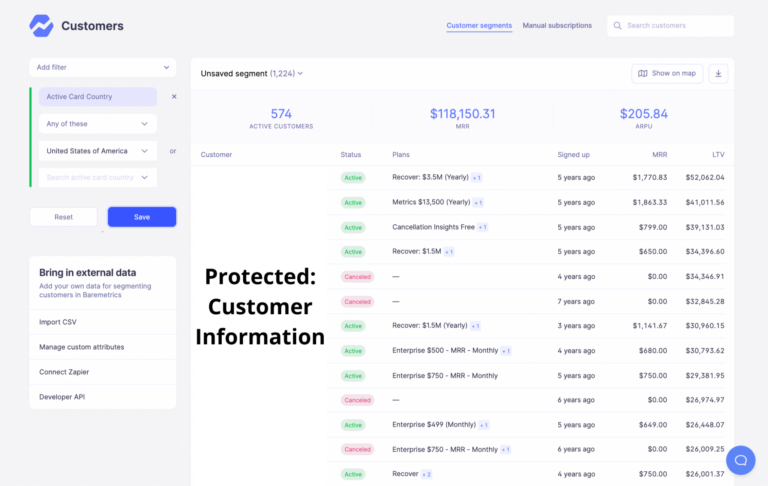Table of Contents
More Articles

Challenge: UXPin needed a tool to consolidate their subscription data and track metrics.
Solution: They signed up for Baremetrics. Right away, its toolkit replaced their in-house solution and made it easy to track metrics and segment customers.
Result: Baremetrics has saved the UXPin team more than 50 hours of maintenance on the in-house tool. This allows their team to focus on product, sales, and growth.
UXPin is a code-based design tool that simplifies and unifies product development process by bringing code components to the design stage. Its extensive platform allows teams of all sizes to collaborate and develop powerful prototypes more efficiently.
UXPin offers four subscription levels to suit the design needs of companies ranging from startups to large enterprises. Industry leaders like Johnson & Johnson, PayPal, and Amazon rely on UXPin to streamline and accelerate their design processes.
Baremetrics spoke to UXPin’s co-founder and CFO Marcin Kowalski to learn more about how they use Baremetrics to track financial growth, segment customers, and respond immediately to problems.
A need to consolidate financial data in one place
UXPin was founded in Poland in 2010. At that time, they used both PayLane and PayPal to process payments. Within a few years, UXPin moved to the United States and was able to migrate Poland-based subscriber data from PayLane, but not PayPal. This was a major issue because their Poland-based PayPal customers made up a significant portion of UXPin’s revenue.
Marcin and his team faced a decision. Either they maintain the Polish PayPal account and establish a separate payment processor based in the US, or make existing customers cancel and resubscribe using the new PayPal account.
They decided to maintain their Polish account. After all, according to Kowalski, they anticipated a risk of losing around half of their Monthly Recurring Revenue (MRR) by asking people to manually switch.
Maintaining two separate payment processors proved to be challenging, especially when it came to consolidating and analyzing the data. In order to do this, UXPin built internal tools to analyze activity based on algorithms that recognized events like expansion, contraction, and lost MRR.
Like most internal tools, UXPin’s monitoring tool required ongoing maintenance. It would work for a few months, then suddenly crash, requiring Kowalski to spend days figuring out the problem. What’s more, the data took a long time to load and didn’t provide the insights they actually needed.
“We were completely blind. We didn’t fully understand what was going on with our customer accounts,” says Marcin Kowalski.
Eventually, UXPin’s Poland-based subscribers using PayPal either ended their subscriptions or encountered a billing issue that served as an opportunity to redirect them to the new US-based billing system on Stripe. By October 2020, 99% of UXPin’s customers were paying via Stripe.
It was around this time that UXPin switched to Baremetrics.
In order to get a clear picture of their financial health and support growth, UXPin needed to:
- Analyze Stripe data efficiently
- Aggregate and segment customer data to support sales activities
“It’s common for early stage founders to over-complicate things. My advice would be to use what is simple and track only the most important metrics instead of building something huge and complicated.”
MARCIN KOWALSKI
COO UXPin
Baremetrics simplifies data analytics and customer segmentation
26+ Stripe Analytics in One Platform
Stripe is the leading payment processing service for SaaS and subscription businesses. Its platform handles recurring payments from customers all over the world, supports different pricing models, and has developer-friendly features that allow for limitless customization.
Stripe’s in-app metrics feature, however, is limited to just 16 metrics. Growing SaaS & subscription companies upgrade to Baremetrics for efficient, accurate, and in-depth reporting.
The UXPin team checks the Baremetrics Control Center frequently to keep a pulse on financial activity. Here they can view MRR, Net Revenue, Average Revenue Per User, MRR growth rate, and 17 other metrics- all in one place.
Below is Baremetrics’ actual control center. You can see it in real-time here!
Baremetrics tracks subscription data and calculates key business metrics. Baremetrics allows UXPin to track progress towards growth goals, identify and respond immediately to issues, and feel a sense of control over their finances.
And because the tool integrates with Stripe and therefore doesn’t require maintenance, the UXPin team has saved upwards of 50 hours of engineering hours on their previous reporting tool.
Powerful customer information supports their sales team
UXPin’s sales team uses Baremetrics to segment customers based on attributes like MRR and geographic location.
They can also view a customer’s entire journey with UXPin, including events like free trials, payment failure, upgrades, downgrades, and more.
Here’s what the customer segmentation tool looks like when Baremetrics segments customers by geographic location, or in other words, where the active credit card on file is located:
The Future of UXPin
UXPin recently launched Merge, a new technology that allows users to design with code components. UXPin also launched an integration with Storybook, which simplifies the design process for design and dev teams.
Learn more about UXPin
To learn more about UXPin, definitely check out their blog. They have a ton of resources about product development and collaborative design.
UXPin is one of 900+ subscription-based companies using Baremetrics to understand key metrics and accelerate growth. To see how Baremetrics can make a difference for your business, start a free trial today.





